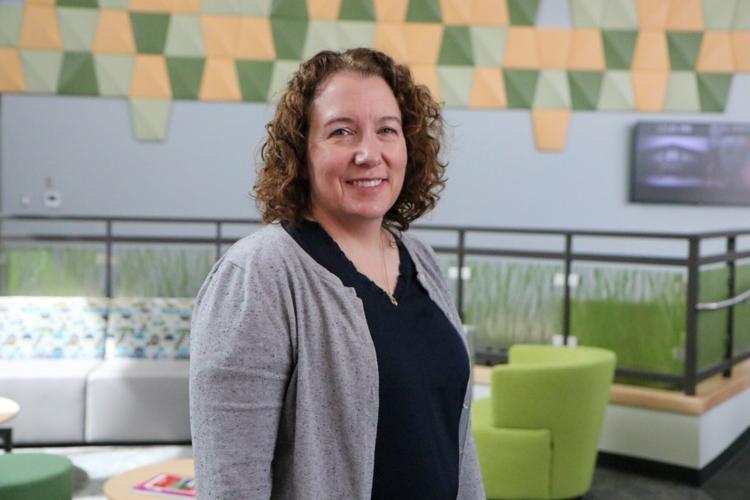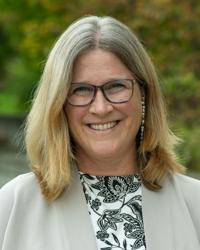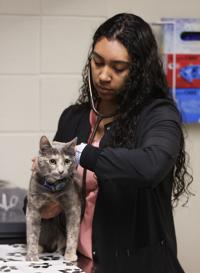Dr. Joanna Fischer sees the need for graduates of the veterinary technology program at Yakima Valley College. As program director, she knows they often get several job offers and can work in a variety of animal health roles.
She also remembers from when she was a practicing veterinarian in the Yakima Valley how important technicians are for increasingly busy veterinarians, who are in demand more than ever. "A well-trained veterinary technician can take a huge load off veterinarians," Fischer said.
A nationwide shortage of veterinary professionals isn't new. But it became more acute in the Yakima Valley in 2023 with the closing of the Harrah Veterinary Clinic, a devastating fire at the Selah Veterinary Hospital and the closing of Yakima Pet Emergency Service in Yakima.
The emergency service closed Dec. 31 because of a shortage of veterinarians. Its website directs pet owners to call Mid-Columbia Pet Emergency Services in Pasco.
The Selah facility partially reopened in early December after a July fire gutted the back half of the building and caused severe secondary heat and smoke damage to the rest of the structure. Though construction will continue for months, the partial reopening was big news for the hospital's veterinary staff and clients.
No elective surgeries such as routine spays, neuters and dental cleaning appointments are taking place until the entire building is completed, according to the hospital's website. There's limited kennel and surgical space until the work is done.
"At this time, we are currently not accepting new clients," its website says. "We apologize for this, but we feel we must focus on our current client and patient family at this time."
No new clients
"Not taking new clients" is a phrase familiar to too many companion animal and livestock owners seeking a new veterinarian. The demand for veterinary care has grown, but the number of veterinarians and veterinary technicians has not kept pace with the need.
At the same time, some veterinarians are retiring or stepping away for other roles. Veterinary professionals face a demanding and emotionally stressful workload that contributes to burnout, compassion fatigue and higher suicide rates. Amid all those other challenges, veterinary school debt can be overwhelming.
Efforts are underway on the national and state levels to remedy the shortage of veterinarians. Eleven new veterinary colleges have been proposed in recent years, including one at Utah State University. The university is moving forward with plans for its first class of 40 veterinary college students in fall 2025, Malinda Larkin wrote in a September article on the American Veterinary Medical Association website.
The shortage has received attention in Washington state as well. The Washington State Veterinary Medical Association is asking the Legislature to fund 20 additional in-state students annually at Washington State University's College of Veterinary Medicine for four years. The organization seeks $1.25 million per class per year, for a total of approximately $5 million over four years.
"A severe workforce shortage in our state is restricting the delivery of veterinary medical services. Not enough veterinarians are being trained to care for either our farm or companion animals," a flyer from the group said.
The group said the shortage is hitting rural and urban parts of Washington.
"This is a critical issue concerning the safety of our food supply and public health, and for families who cannot get timely care for their companion animals," the flyer said.
Many applicants, too few slots
Earning a Doctor of Veterinary Medicine degree is never easy, but thousands of exemplary applicants willing to do the work are turned away every year because of the limited number of students accepted at the 31 U.S. and two Caribbean veterinary colleges.
Challenging coursework and outstanding grades are required for application to veterinary college, but acceptance isn't a given, even with high grades in all of the required prerequisites. Some who want to be veterinarians apply to multiple schools inside and outside the United States because it's so competitive.
"For the class of 2027, there were exactly 2,027 applicants for 140 slots. This year we had even more applicants — 2,400 applicants" for 140 slots, said Dr. Dori Borjesson, dean of the Washington State University College of Veterinary Medicine in Pullman.
Applicants include students from all over the world, but they're primarily from Washington, Idaho, Montana and Utah, she said.
"It's unfortunate; even people with a strong dream and a strong passion may not get (into veterinary college) for a few years," Borjesson said.
Once accepted, veterinary college students face an intense course load of science-based classes. Cost is a major factor, too. Veterinary school is expensive, just as it is for other medical careers. But veterinarians aren't paid as well as physicians, meaning it will take longer to pay off their likely substantial student debt.
Though veterinary starting salaries rose in 2023 and educational debt held steady, "approximately 1 in 3 of this year’s veterinary graduates have debt greater than $200,000," R. Scott Nolen wrote in a November article posted on the American Veterinary Medical Association website.
The mean starting compensation in 2023 was $124,295 for graduates of U.S. and Caribbean veterinary colleges entering full-time employment, Nolen wrote.
Nolen's article centers on a talk by Dr. Chris Doherty during a virtual medical association forum in October. Doherty mentioned findings from the 2023 AVMA Graduating Senior Survey, which will be made available in the 2024 State of the Profession Report, Nolen wrote.
Starting salaries for veterinarians continue to rise "and educational debt levels are holding steady, leading to a debt-to-income ratio not seen since 2004," he wrote. "Further, this year’s graduates received offers at near record-high levels."
Veterinary technician program
Veterinary technologists and technicians, who play crucial roles in the success of veterinary hospitals, also carry financial burdens from college. In a 2022 survey by the National Association of Veterinary Technicians in America, more than a third of veterinary technicians reported having student debt, and 1 in 3 reported having a second job — most often at full-time.
Pay for veterinary technicians is rising; the average veterinary technician is earning 25% more than in 2016, when the last survey took place. But earning an average $26.50 per hour still isn't enough for technicians, who "are a vital part of the industry," said Fischer, the program director of the YVC veterinary technology program.
"Classically their pay has not been very good for their level of expertise. That's changed. It is getting better," she said.
YVC's associate of applied science degree in veterinary technology is a two-year course, with a new class of 25 students beginning every fall. Graduates take national and state board examinations to be licensed as veterinary technicians. A total of 331 students have graduated since the program began in 1999.
The program involves numerous science-based classes, labs on campus and at area farms, animal care and more. There are some long days, as the program website indicates. "It is a tough road but they're amazing students," Fischer said.
Though the national veterinary technician association has tried to educate the greater public, "to some degree there's still a bit of a disconnect about what a veterinary technician does," Fischer said.
"Veterinary technicians do anesthesia. It's a veterinary technician who is running the anesthesia while the doctor is doing the surgery," she said. Veterinary technicians "are doing the vast majority of all radiology." They communicate with clients and are surgical assistants, among other roles.
"They are the veterinary equivalent of nurses" and handle many responsibilities "with varying levels of supervision from a veterinarian," Fischer added.
Dr. Rena Carlson, the president of the American Veterinary Medical Association, wrote in a recent blog post about the contributions that veterinary technicians, veterinary technologists and veterinary technician specialists make.
"Empowering veterinary technicians to use all of their training and skills in their daily work is one of the most effective ways to address the lingering workforce challenges that many of our practices face," the post said.
Attracting veterinary professionals
Attracting veterinary professionals to rural areas can be more challenging, as it can be for attracting other professionals.
"When they graduate, they have debt and rural mixed practices cannot begin to pay the salaries that urban small animal practices pay," Borjesson said. "There's signing bonuses; there's offers of debt loan repayment. That will always be the case."
Fischer, who is from Western Washington and graduated from Washington State, has always worked in rural practice. Her first job out of veterinary school, in 2000, was working for Dr. Mike Beksinski at the Selah Veterinary Hospital, which he opened after he and wife Linda moved to Selah in 1976.
She left the Selah Veterinary Hospital in 2006 and joined the staff at the Pet Health Clinic in Sunnyside, where she remained until she joined the Yakima Valley College faculty full-time in the fall of 2022 after working as an adjunct instructor.
"It's hard to attract veterinarians to a rural area to practice when owners are retiring. We're having a harder time getting new veterinarians to come in," she said. That has had "more of an impact than the pandemic pet explosion, as far as our area.
"Just to attract an associate veterinarian to this area can be difficult."
Rural veterinarians provide the same level of care as urban veterinarians and prescribe the same drugs, Fischer added, "but we cannot charge our clients what they would charge in a very affluent area. The demographics won't support it."
Also, "It's hard to be a sole veterinarian in a practice. It does help to have the support of another veterinarian around so you can balance ideas off each other," Fischer said.
The need for more veterinarians who practice food animal medicine has become so acute in many areas throughout the United States that they've been designated as shortage regions by the National Institute of Food and Agriculture. In doing so, the organization can arrange educational loan repayment agreements with veterinarians who agree to provide veterinary services in veterinarian shortage situations for a certain amount of time.
In caring for animals, veterinary professionals safeguard human health when there are outbreaks of zoonotic diseases, which can pass from animals to humans or vice versa. And food animal health is critical.
Washington state has five shortage regions that cover eight counties: Grant, Okanogan, Columbia, Adams, Whitman, Garfield, Asotin and Walla Walla.
For Columbia, Garfield, Asotin and Walla Walla counties, "there are two food animal veterinarians in the entire region, both nearing retirement," according to an online summary with information about the region's needs.
"Shortage of veterinarians in Southeast WA has passed the critical issue level and is nearing crisis level," it says. "This shortage is not only impacting the care of food animals and potentially the production of safe food from these animals, but it is also greatly taking its toll on the mental and physical health of the current vets providing services in the area."
Supporting veterinary professionals
Along with long work days, veterinarians often serve the animals in their communities in other important ways. Some work closely with animal rescue organizations, sometimes at discounted rates, or even donate their time or foster homeless animals. They speak to 4-H groups about companion animal training and care for all kinds of livestock and other animals.
Recognizing the important contributions of veterinarians and veterinary professionals, some communities pursue ways to identify and support students interested in those careers. YVC is doing some outreach, Fischer said.
"We brought some area high school counselors in and we talked to them about our programs. We talk to people as much as we can," she added. "The pay is definitely getting better. I think it's less likely for burnout.
"And if you love animals, you will never be bored. This job is, at the very least, never, ever, ever boring."
Communities can advocate for potential and current veterinary professionals, Borjesson said. "Some communities have scholarship programs, pipeline programs, identify students who may be interested in coming back to their communities" after college.
Some Yakima-area veterinary practices are taking new clients, including the Terrace Heights Family Pet Clinic and Companion Animal Clinic. Most practices will take animals on an emergency basis or will euthanize them to end their suffering, Fischer noted.
Pets are part of people's families, and she knows the urgency when an animal needs medical care. But veterinary professionals and staff members "are working as hard as they can," she said.
"In our area, they're trying to absorb new people coming into the area and from practices that closed down. But they're still trying to provide the right kind of care for their patients," she said. "The most important thing that your community can do is just understand that veterinarians are doing the best they can.
"It breaks our heart when we have to turn people away because we do not have time to see your pet that day," Fischer said.
"Veterinarians and veterinary staff are doing the very best they can. They are working above capacity; they really are," she added.
"The clients, the pet owners, they're all in a tough spot. It has really had a huge impact on our community because these people love their pets."













(1) comment
Great article Tammy Ayer. Yakima County is definitely in a very tight situation with trying to find animal care, especially in the emergency care dept. Very expensive/long drive to the Tri-Cities.
Log in to reply
Comments are now closed on this article.
Comments can only be made on article within the first 3 days of publication.